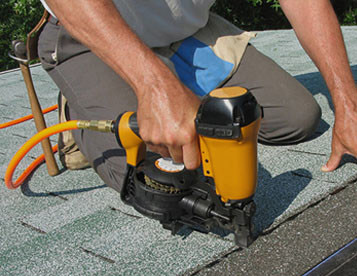Roof Repair & Restoration in Phoenix, AZ
Local homeowners in Mesa know firsthand the value of a high-quality roof. Blazing summer temperatures in the triple digits and sun damage from UV rays can weaken your roof and make it susceptible to leaks and other damage. Not only that, but the monsoon season brings heavy rains and strong winds that can easily snatch tiles and shingles off of your roof.
When you need reliable roof repair services in the Phoenix Valley or beyond, look no further than Right Way Roofing. Our team of certified roofing contractors have the expertise and skill to create high-quality roofing solutions for any budget. Give us a call today to schedule an appointment or speak with one of our team members.
"*" indicates required fields
ROOFING REVIEWS & TESTIMONIALS
With a trusted reputation, we like to offer access to official reviews in order to give you better piece of mind.
Click on the links to read what our customers are saying!
I read a google review that RWR didn't like to come to Tucson to do work. They may not want to drive down from Mesa to do a $300 repair but I live 30 minutes south of Tucson and they didn't seem to mind working here. Actually, I got 3 other estimates. They were not the cheapest (by $500) but they were not the most expensive either.
I would highly recommend this company to do your roofing replacement.
They worked with us on how we could split the payment on our cc's. They did what they said they were going to do & we HIGHLY recommend them.
Types of Roofs We Repair
Residents in the City of Sunshine need custom roofing solutions that can withstand the blazing desert heat and monsoon winds. Our team of roofing contractors offers tailored roofing services for residential and commercial properties. We offer a wide range of roofing systems, including:
Shingle Roofing Repair
Asphalt shingles are one of the most popular roofing options on the market because of their affordability and strength. We offer extensive shingle roof repair services for homes in Mesa, Arizona and will work with you to take care of any problem, from missing shingles to cracked roofing.
Tile Roofing Repair
Tile roofing comes in a variety of materials, all of which work to absorb heat and keep your home cool when temperatures reach the triple digits in the summertime. Whether you’re struggling with a leak or missing tiles, our available tile roof repair services in Mesa will fix the problem in no time.
Foam Roofing Repair
Foam roofing has been around for decades and is a popular roof material due to its easy installation and maintenance. Our team has the experience and equipment to efficiently repair and maintain foam roofing systems so your home or business in Mesa is protected no matter what.
Elastomeric Roof Coating Repair
If you see buildings with a white coating on the roof, that’s an elastomeric roof coating. Think of it like a rubber roof sealant that’s flexible and protects your property from the elements. Our team is ready to get to work repairing your elastomeric roof with minimal disruptions to your daily life.
Flat Roofing Repair
For businesses or residential properties that cover large areas of square footage, a flat roof offers weather protection and proper rainwater drainage at an affordable price. Our team offers dependable flat roofing repair services in Mesa, Arizona and will make sure the drainage system is working properly to prevent water pooling or leaks.
Built-Up Roofing Repair
As the name suggests, built-up roofing systems layer various materials on your roof to create a solid, waterproof roofing solution for your home or business. No matter how deep the damage, we’ll quickly get to work repairing your built-up roof so it’s ready to go.
Elastomeric Roof Coating Repair
If you see buildings with a white coating on the roof, that’s an elastomeric roof coating. Think of it like a rubber roof sealant that’s flexible and protects your property from the elements. Our team is ready to get to work repairing your elastomeric roof with minimal disruptions to your daily life.
Our Roof Repair Process
When looking for a reliable roofing service, you want to know what you’re getting into. Our team follows a proven process for high-quality results:
- Initial Roof Inspection – A roof inspection identifies all visible damage.
- Damage Assessment – We determine the depth and scope of repairs needed.
- Thorough Repair Proposal – You’ll receive a clear, formal plan and quote.
- Transparent Communication – No surprises. You’ll know what’s happening at every step.
- Extensive Roof Repairs – Our skilled team gets to work quickly.
- Final Inspection – We ensure the repair is solid and complete.

ROOF Financing Options
We Also Offer Warranties for Our Roofs!
Signs Your Roof Needs Repair in Arizona
Your roofing system has an intricate layout of different components that all work together to keep your home cool and protected from the elements. If something goes wrong, it can quickly lead to bigger problems later down the road. Our extensive roof repair services in Mesa are designed to stop the problem in its tracks and prevent further damage.
We’re equipped to handle some of the most common roofing problems, including:
Why Homeowners Choose Right Way Roofing

Roof Repair FAQs
How much money does a roof repair usually cost?
Roof repair costs vary depending on the type of roof, the extent of the damage, and the materials required.
For those considering a replacement, the cost of a new roof is higher, but it can add long-term value and protection.
Why should I consider a roof restoration?
Roof restoration is a smart choice when your roof is still structurally sound but starting to show age-related damage. This option is especially beneficial in Phoenix, where prolonged sun exposure and sudden monsoons can wear down roofing materials prematurely.
Why should I consider a roof restoration?
Roof restoration is a smart choice when your roof is still structurally sound but starting to show age-related damage. This option is especially beneficial in Phoenix, where prolonged sun exposure and sudden monsoons can wear down roofing materials prematurely.
How long does a roof repair take?
The timeline depends on the extent of the repairs. Minor repairs could take a few hours, while bigger projects may take longer.
What types of roofs do you repair?
We repair all types of roofs, including tile, shingle, foam, flat roofs, and built-up roofs.
Do you offer emergency roof repairs?
At Right Way Roofing, we’re here whenever you need us. We offer emergency roofing services to keep your home or business safe and protected.
Can I get my roof fixed during the monsoon season?
Yes, our skilled AZ roofing crews can complete repairs during monsoon season, though scheduling may depend on weather conditions. We use protective coverings and work in safe intervals between storms to prevent further damage.
Will homeowners' insurance cover mild to severe roof damage?
Insurance generally covers damage caused by storms, hail, wind, or other sudden events. Normal wear and tear, however, is not included.
Our experienced team can help you navigate the claims process and even communicate with your insurer if needed, making sure you get the coverage you’re entitled to.
Roof Repair for Homes and Commercial Properties
Whether you’re a homeowner in the area or just opened the doors of your new small business, our team is ready to help. When you need dependable roof repair options, our exceptional services keep your home or business protected all year round. Our team also provides dependable roof replacement services in Mesa, Arizona and the surrounding areas. Whether you require a simple fix or a brand new roof, our staff has the skills and training necessary to resolve your issues.









